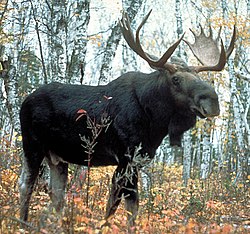| Alceini | |
|---|---|
 | |
| Alces alces | |
| Scientific classification | |
| Domain: | Eukaryota |
| Kingdom: | Animalia |
| Phylum: | Chordata |
| Class: | Mammalia |
| Order: | Artiodactyla |
| Family: | Cervidae |
| Subfamily: | Capreolinae |
| Tribe: | Alceini |
| Genera | |
Alceini is a tribe of deer, containing the extant genus Alces and the extinct genera Cervalces and Libralces . The only extant species in this tribe is the moose. [1] [2] [3]